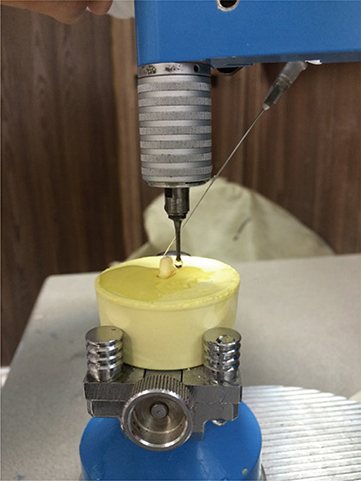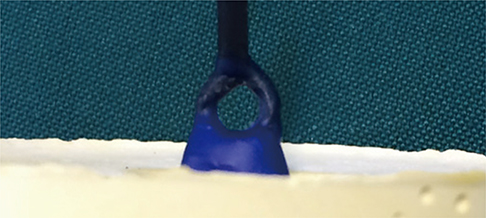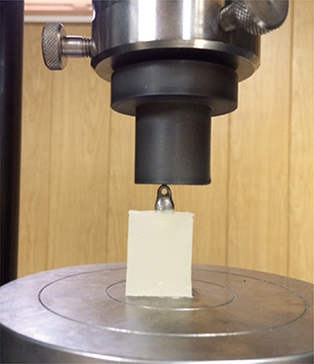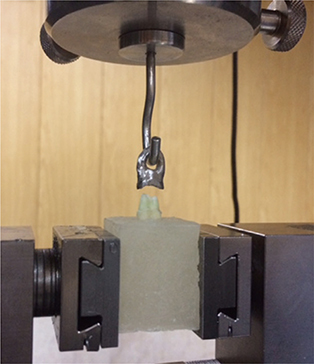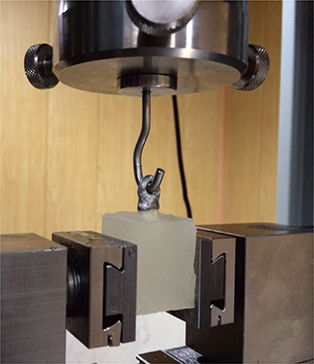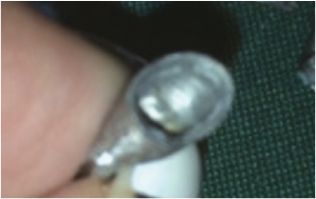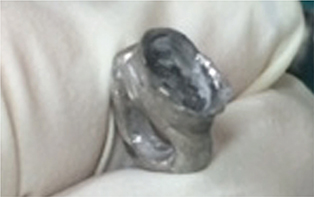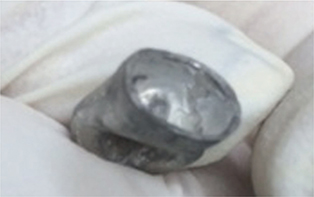J Adv Prosthodont.
2016 Oct;8(5):404-410. 10.4047/jap.2016.8.5.404.
Effect of GLUMA desensitizer on the retention of full metal crowns cemented with Rely X U200 self-adhesive cement
- Affiliations
-
- 1Prosthodontics Department. Islamic Azad University-Dental Branch, Teheran, Iran.
- 2Oral Medicine Department. Islamic Azad University-Dental Branch, Teheran, Iran. drarashazizi@yahoo.com
- KMID: 2355445
- DOI: http://doi.org/10.4047/jap.2016.8.5.404
Abstract
- PURPOSE
Considering the importance of retention in the success and long-term clinical service of fixed partial dentures (FPDs) as well as the existing controversy regarding the effect of GLUMA desensitizer on the retention of full metal crowns cemented with RelyX U200 self-adhesive cement, this study aimed to assess the effect of GLUMA desensitizer on the retention of full metal crowns cemented using RelyX U200.
MATERIALS AND METHODS
In this experimental study, 20 sound human premolars were prepared; a 0.5 mm chamfer finish line was prepared above the cementoenamel junction. The teeth were randomly assigned to two groups: a desensitizer group (n = 10, treated with GLUMA desensitizer) and a control (n = 10, no surface treatment). Full metal crowns were fabricated of base metal alloy and had a ring. All crowns were cemented with RelyX U200 and subjected to retention test by using a universal testing machine. The data were analyzed using SPSS version 20 and independent t-test.
RESULTS
The mean tensile bond strength was significantly higher in the GLUMA desensitizer group (230.63 ± 63.8 N) compared to the control group (164.45 ± 39.3 N) (P≤.012).
CONCLUSION
GLUMA desensitizer increases the tensile bond strength of RelyX U200 self-adhesive cement to dentin.
Keyword
Figure
Reference
-
1. Orsi IA, Varoli FK, Pieroni CH, Ferreira MC, Borie E. In vitro tensile strength of luting cements on metallic substrate. Braz Dent J. 2014; 25:136–140.2. Al-Omari WM, Al-Wahadni AM. Convergence angle, occlusal reduction, and finish line depth of full-crown preparations made by dental students. Quintessence Int. 2004; 35:287–293.3. Zidan O, Ferguson GC. The retention of complete crowns prepared with three different tapers and luted with four different cements. J Prosthet Dent. 2003; 89:565–571.4. Ayad MF, Johnston WM, Rosenstiel SF. Influence of tooth preparation taper and cement type on recementation strength of complete metal crowns. J Prosthet Dent. 2009; 102:354–361.5. Jalandar SS, Pandharinath DS, Arun K, Smita V. Comparison of effect of desensitizing agents on the retention of crowns cemented with luting agents: an in vitro study. J Adv Prosthodont. 2012; 4:127–133.6. Sailer I, Oendra AE, Stawarczyk B, Hämmerle CH. The effects of desensitizing resin, resin sealing, and provisional cement on the bond strength of dentin luted with self-adhesive and conventional resincements. J Prosthet Dent. 2012; 107:252–260.7. Chen C, Xie H, Song X, Burrow MF, Chen G, Zhang F. Evaluation of a commercial primer for bonding of zirconia to two different resin composite cements. J Adhes Dent. 2014; 16:169–176.8. Yim NH, Rueggeberg FA, Caughman WF, Gardner FM, Pashley DH. Effect of dentin desensitizers and cementing agents on retention of full crowns using standardized crown preparations. J Prosthet Dent. 2000; 83:459–465.9. Johnson GH, Hazelton LR, Bales DJ, Lepe X. The effect of a resin-based sealer on crown retention for three types of cement. J Prosthet Dent. 2004; 91:428–435.10. Acar O, Tuncer D, Yuzugullu B, Celik C. The effect of dentin desensitizers and Nd:YAG laser pre-treatment on microtensile bond strength of self-adhesive resin cement to dentin. J Adv Prosthodont. 2014; 6:88–95.11. Aranha AC, Siqueira Junior Ade S, Cavalcante LM, Pimenta LA, Marchi GM. Microtensile bond strengths of composite to dentin treated with desensitizer products. J Adhes Dent. 2006; 8:85–90.12. Stawarczyk B, Hartmann L, Hartmann R, Roos M, Ender A, Ozcan M, Sailer I, Hämmerle CH. Impact of Gluma Desensitizer on the tensile strength of zirconia crowns bonded to dentin: an in vitro study. Clin Oral Investig. 2012; 16:201–213.13. Stawarczyk B, Hartmann R, Hartmann L, Roos M, Ozcan M, Sailer I, Hämmerle CH. The effect of dentin desensitizer on shear bond strength of conventional and self-adhesive resin luting cements after aging. Oper Dent. 2011; 36:492–501.14. Oshima M, Hamba H, Sadr A, Nikaido T, Tagami J. Effect of polymer-based desensitizer with sodium fluoride on prevention of root dentin demineralization. Am J Dent. 2015; 28:123–127.15. Dündar M, Cal E, Gökçe B, Türkün M, Ozcan M. Influence of fluoride- or triclosan-based desensitizing agents on adhesion of resin cements to dentin. Clin Oral Investig. 2010; 14:579–586.16. Saraç D, Külünk S, Saraç YS, Karakas O. Effect of fluoride-containing desensitizing agents on the bond strength of resin-based cements to dentin. J Appl Oral Sci. 2009; 17:495–500.17. Huh JB, Kim JH, Chung MK, Lee HY, Choi YG, Shim JS. The effect of several dentin desensitizers on shear bond strength of adhesive resin luting cement using self-etching primer. J Dent. 2008; 36:1025–1032.18. Soeno K, Taira Y, Matsumura H, Atsuta M. Effect of desensitizers on bond strength of adhesive luting agents to dentin. J Oral Rehabil. 2001; 28:1122–1128.19. Sailer I, Tettamanti S, Stawarczyk B, Fischer J, Hämmerle CH. In vitro study of the influence of dentin desensitizing and sealing on the shear bond strength of two universal resin cements. J Adhes Dent. 2010; 12:381–392.20. Hitz T, Stawarczyk B, Fischer J, Hämmerle CH, Sailer I. Are self-adhesive resin cements a valid alternative to conventional resin cements? A laboratory study of the long-term bond strength. Dent Mater. 2012; 28:1183–1190.21. Di Hipólito V, Rodrigues FP, Piveta FB, Azevedo Lda C, Bruschi Alonso RC, Silikas N, Carvalho RM, De Goes MF, Perlatti D'Alpino PH. Effectiveness of self-adhesive luting cements in bonding to chlorhexidine-treated dentin. Dent Mater. 2012; 28:495–501.22. Joshi S, Gowda AS, Joshi C. Comparative evaluation of NovaMin desensitizer and Gluma desensitizer on dentinal tubule occlusion: a scanning electron microscopic study. J Periodontal Implant Sci. 2013; 43:269–275.23. Munksgaard EC, Asmussen E. Bond strength between dentin and restorative resins mediated by mixtures of HEMA and glutaraldehyde. J Dent Res. 1984; 63:1087–1089.24. Qin C, Xu J, Zhang Y. Spectroscopic investigation of the function of aqueous 2-hydroxyethylmethacrylate/glutaraldehyde solution as a dentin desensitizer. Eur J Oral Sci. 2006; 114:354–359.25. Nakabayashi N, Watanabe A, Gendusa NJ. Dentin adhesion of "modified" 4-META/MMA-TBB resin: function of HEMA. Dent Mater. 1992; 8:259–264.26. Arrais CA, Chan DC, Giannini M. Effects of desensitizing agents on dentinal tubule occlusion. J Appl Oral Sci. 2004; 12:144–148.27. Kolker JL, Vargas MA, Armstrong SR, Dawson DV. Effect of desensitizing agents on dentin permeability and dentin tubule occlusion. J Adhes Dent. 2002; 4:211–221.
- Full Text Links
- Actions
-
Cited
- CITED
-
- Close
- Share
- Similar articles
-
- The Effect Of Temporary Cement And Desensitizer On The Bond Strength Of Luting Cements
- Effect Of Dentin Desensitizers On Shear Bond Strength Of Resin Cements
- Comparison of effect of desensitizing agents on the retention of crowns cemented with luting agents: an in vitro study
- The effect of dentin desensitizers and Nd:YAG laser pre-treatment on microtensile bond strength of self-adhesive resin cement to dentin
- A study on the complete retrieval system of the cementation type implant abutment

